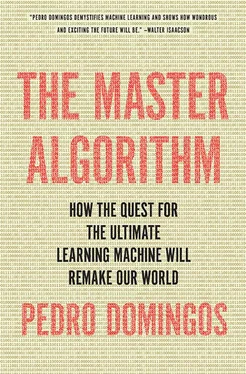In general, we have to deal with many constraints at once (one per example, in the case of SVMs). Suppose you wanted to get as close as possible to the North Pole but couldn’t leave your room. Each of the room’s four walls is a constraint, and the solution is to follow the compass until you bump into the corner where the northeast and northwest walls meet. We say that these two walls are the active constraints because they’re what prevents you from reaching the optimum, namely the North Pole. If your room has a wall facing exactly north, that’s the sole active constraint, and the solution is a point in the middle of it. And if you’re Santa and your room is already over the North Pole, all constraints are inactive, and you can just sit there pondering the optimal toy distribution problem instead. (Traveling salesmen have it easy compared to Santa.) In an SVM, the active constraints are the support vectors since their margin is already the smallest it’s allowed to be; moving the frontier would violate one or more constraints. All other examples are irrelevant, and their weight is zero.
In reality, we usually let SVMs violate some constraints, meaning classify some examples incorrectly or by less than the margin, because otherwise they would overfit. If there’s a noisy negative example somewhere in the middle of the positive region, we don’t want the frontier to wind around inside the positive region just to get that example right. But the SVM pays a penalty for each example it gets wrong, which encourages it to keep those to a minimum. SVMs are like the sandworms in Dune : big, tough, and able to survive a few explosions from slithering over landmines but not too many.
Looking around for applications, Vapnik and his coworkers soon alighted on handwritten digit recognition, which their connectionist colleagues at Bell Labs were the world experts on. To everyone’s surprise, SVMs did as well out of the box as multilayer perceptrons that had been carefully crafted for digit recognition over the years. This set the stage for a long-running, wide-ranging competition between the two. SVMs can be seen as a generalization of the perceptron, because a hyperplane boundary between classes is what you get when you use a particular similarity measure (the dot product between vectors). But SVMs have a major advantage compared to multilayer perceptrons: the weights have a single optimum instead of many local ones and so learning them reliably is much easier. Despite this, SVMs are no less expressive than multilayer perceptrons; the support vectors effectively act as a hidden layer and their weighted average as the output layer. For example, an SVM can easily represent the exclusive-OR function by having one support vector for each of the four possible configurations. But the connectionists didn’t give up without a fight. In 1995, Larry Jackel, the head of Vapnik’s department at Bell Labs, bet him a fancy dinner that by 2000 neural networks would be as well understood as SVMs. He lost. But in return, Vapnik bet that by 2005 no one would use neural networks any more, and he also lost. (The only one to get a free dinner was Yann LeCun, their witness.) Moreover, with the advent of deep learning, connectionists have regained the upper hand. Provided you can learn them, networks with many layers can express many functions more compactly than SVMs, which always have just one layer, and this can make all the difference.
Another notable early success of SVMs was in text classification, which proved a major boon because the web was then just taking off. At the time, Naïve Bayes was the state-of-the-art text classifier, but when every word in the language is a dimension, even it can start to overfit. All it takes is a word that, by chance, occurs in, say, all sports pages in the training data and no others, and Naïve Bayes starts to hallucinate that every page containing that word is a sports page. But, thanks to margin maximization, SVMs can resist overfitting even in very high dimensions.
Generally, the fewer support vectors an SVM selects, the better it generalizes. Any training example that is not a support vector would be correctly classified if it showed up as a test example instead because the frontier between positive and negative examples would still be in the same place. So the expected error rate of an SVM is at most the fraction of examples that are support vectors. As the number of dimensions goes up, this fraction tends to go up as well, so SVMs are not immune to the curse of dimensionality. But they’re more resistant to it than most.
Practical successes aside, SVMs also turned a lot of machine-learning conventional wisdom on its head. For example, they gave the lie to the notion, sometimes misidentified with Occam’s razor, that simpler models are more accurate. On the contrary, an SVM can have an infinite number of parameters and still not overfit, provided it has a large enough margin.
The single most surprising property of SVMs, however, is that no matter how curvy the frontiers they form, those frontiers are always just straight lines (or hyperplanes, in general). The reason that’s not a contradiction is that the straight lines are in a different space. Suppose the examples live on the ( x,y ) plane, and the boundary between the positive and negative regions is the parabola y = x 2 . There’s no way to represent it with a straight line, but if we add a third coordinate z , meaning the data now lives in ( x,y,z ) space, and we set each example’s z coordinate to the square of its x coordinate, the frontier is now just the diagonal plane defined by y = z . In effect, the data points rise up into the third dimension, some rise more than others by just the right amount, and presto-in this new dimension the positive and negative examples can be separated by a plane. It turns out that we can view what SVMs do with kernels, support vectors, and weights as mapping the data to a higher-dimensional space and finding a maximum-margin hyperplane in that space. For some kernels, the derived space has infinite dimensions, but SVMs are completely unfazed by that. Hyperspace may be the Twilight Zone, but SVMs have figured out how to navigate it.
Climbing the ladder
Two things are similar if they agree with one another in some respects. If they agree in some respects, they will probably also agree in others. This is the essence of analogy. It also points to the two main subproblems in analogical reasoning: figuring out how similar two things are and deciding what else to infer from their similarities. So far we’ve explored the “low power” end of analogy, with algorithms like nearest-neighbor and SVMs, where the answers to both these questions are very simple. They’re the most widely used, but a chapter on analogical learning would not be complete without at least a whirlwind tour of the more powerful parts of the spectrum.
The most important question in any analogical learner is how to measure similarity. It could be as simple as Euclidean distance between data points, or as complex as a whole program with multiple levels of subroutines whose final output is a similarity value. Either way, the similarity function controls how the learner generalizes from known examples to new ones. It’s where we insert our knowledge of the problem domain into the learner, making it the analogizers’ answer to Hume’s question. We can apply analogical learning to all kinds of objects, not just vectors of attributes, provided we have a way of measuring the similarity between them. For example, we can measure the similarity between two molecules by the number of identical substructures they contain. Methane and methanol are similar because they have three carbon-hydrogen bonds in common and differ only in the replacement of a hydrogen atom by a hydroxyl group:
Читать дальше












